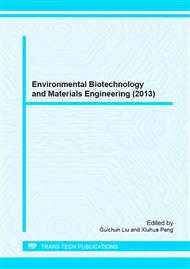[1]
Roberts, T., Hutson, D., Lee, P. & Nicholls, P. Pt. 1: Herbicides and plant growth regulators. (Cambridge: Royal Society of Chemistry, 1998).
Google Scholar
[2]
Chan, K. & Chu, W. Atrazine removal by catalytic oxidation processes with or without UV irradiation: Part I—quantification and rate enhancement via kinetic study. Applied Catalysis B: Environmental 58, 157-163 (2005).
DOI: 10.1016/j.apcatb.2004.12.006
Google Scholar
[3]
Acero, J. L., Stemmler, K. & von Gunten, U. Degradation kinetics of atrazine and its degradation products with ozone and OH radicals: a predictive tool for drinking water treatment. Environmental science & technology 34, 591-597 (2000).
DOI: 10.1021/es990724e
Google Scholar
[4]
Petrier, C., David, B. & Laguian, S. Ultrasonic degradation at 20 kHz and 500 kHz of atrazine and pentachlorophenol in aqueous solution: Preliminary results. Chemosphere 32, 1709-1718 (1996).
DOI: 10.1016/0045-6535(96)00088-4
Google Scholar
[5]
Jain, S., Yamgar, R. & Jayaram, R. Photolytic and photocatalytic degradation of atrazine in the presence of activated carbon. Chemical Engineering Journal 148, 342-347 (2009).
DOI: 10.1016/j.cej.2008.09.006
Google Scholar
[6]
Ventura, A., Jacquet, G., Bermond, A. & Camel, V. Electrochemical generation of the Fenton's reagent: application to atrazine degradation. Water research 36, 3517-3522 (2002).
DOI: 10.1016/s0043-1354(02)00064-7
Google Scholar
[7]
Wackett, L., Sadowsky, M., Martinez, B. & Shapir, N. Biodegradation of atrazine and related s-triazine compounds: from enzymes to field studies. Applied Microbiology and Biotechnology 58, 39-45 (2002).
DOI: 10.1007/s00253-001-0862-y
Google Scholar
[8]
Vallero, M., Hulshoff Pol, L., Lettinga, G. & Lens, P. Effect of NaCl on thermophilic (55 C) methanol degradation in sulfate reducing granular sludge reactors. Water research 37, 2269-2280 (2003).
DOI: 10.1016/s0043-1354(03)00024-1
Google Scholar
[9]
CHEN, R. -h. et al. Degradation of organic wastewater containing Cu–EDTA by Fe–C micro-electrolysis. Transactions of Nonferrous Metals Society of China 22, 983-990 (2012).
DOI: 10.1016/s1003-6326(11)61274-0
Google Scholar
[10]
Lan, S., Ju, F. & Wu, X. Treatment of wastewater containing EDTA-Cu (II) using the combined process of interior microelectrolysis and Fenton oxidation–coagulation. Separation and Purification Technology 89, 117-124 (2012).
DOI: 10.1016/j.seppur.2012.01.009
Google Scholar
[11]
Adams, C. D. & Randtke, S. J. Ozonation byproducts of atrazine in synthetic and natural waters. Environmental science & technology 26, 2218-2227 (1992).
DOI: 10.1021/es00035a022
Google Scholar
[12]
LI, S. F., LIANG, Y., ZHUANG, R. Q. & YE, F. Efficiency of atrazine degradation by O3/H2O2. Environmental science 30. 1425-1429(2009).
Google Scholar
[13]
ZHUANG, G. M., CHANG, A. M. & ZHUANG, P. Y. Ultrasoun in water and wastewater treatment (Eds. ). China Architecture & Building Press, Bei Jing, pp.5-12(2006).
Google Scholar
[14]
Ghosh, P. P. K. & Philip, L. Atrazine degradation in anaerobic environment by a mixed microbial consortium. Water Research 38, 2276-2283 (2004).
DOI: 10.1016/j.watres.2003.10.059
Google Scholar


